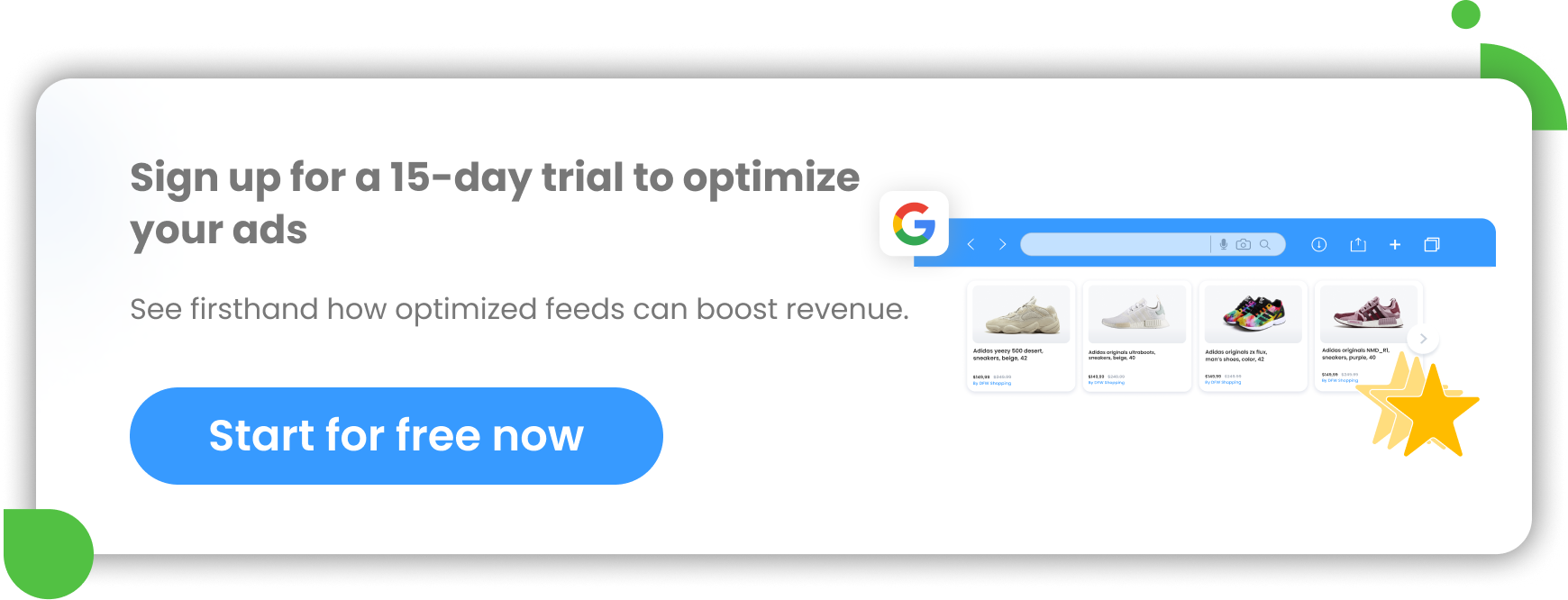In today's digital age, advertising has become an integral part of running a successful business. In the automotive industry, dealerships need to advertise their inventory on various platforms such as Google, Facebook, and Microsoft to attract potential customers.
However, managing and optimizing automotive product data feeds can be a daunting task. It requires constant monitoring, updating, and customization to ensure that the right products are displayed to the right audience.
In this article, we will cover everything you need to know about automotive feed management, including what it is, why it's important, and how to do it effectively. By the end of this article, you'll have a comprehensive understanding of how to manage your automotive feeds and maximize your advertising efforts.
Basics of automotive feeds
In the automotive industry, product feeds are an essential tool for auto retailers to promote their products on search shopping engines or social media.
Automotive product feeds typically contain information about new or used cars, sometimes car parts and other automotive-related products.
The information contained in an automotive product feed includes Google product category
mileage, images, prices, VIN, condition, model and other relevant information. By providing detailed information about their products in the feed, retailers can attract customers who are looking for specific cars and accessories.
Automotive product feeds can be created manually or generated automatically through eCommerce platforms or product feed management tools such as DataFeedWatch.
What is important about automotive feed management?
Maintaining vehicle catalogs is challenging due to the regular addition of new makes and models, and it's crucial to keep your inventory current to optimize your advertising expenses.
It's essential to avoid displaying out-of-stock products to potential customers as it could negatively impact their shopping experience and waste your budget.
To effectively advertise their automotive inventory on Google, Facebook, and Microsoft, dealerships require a scalable way to manage their catalogs.
What might be the solution?
The solution might be investing in a feed management software that can help you by collecting product data from various sources, creating tailored feeds for each of the mentioned platforms, and delivering your optimized listings to all advertising channels.
Automotive feeds for different channels
In today's digital age, the automotive industry has turned towards online platforms to advertise their products and reach a wider audience. Two of the most popular channels for automotive marketing are Google vehicle ads and Facebook Automotive Inventory ads. In this paragraph, we will explore what are the requirements for automotive inventory feeds used to advertise products on these two channels and on Microsoft.
The feed specifications for all these 3 channels are similar but not the same. The required attributes vary slightly from platform to platform. See details below.
Google vehicle ads feed
The Google inventory feed is a comprehensive list of all the vehicles you have along with their descriptive attributes. This feed is the sole source of information for your vehicle ads on Google. The details you provide in it will be what potential customers see when searching for vehicles similar to yours.
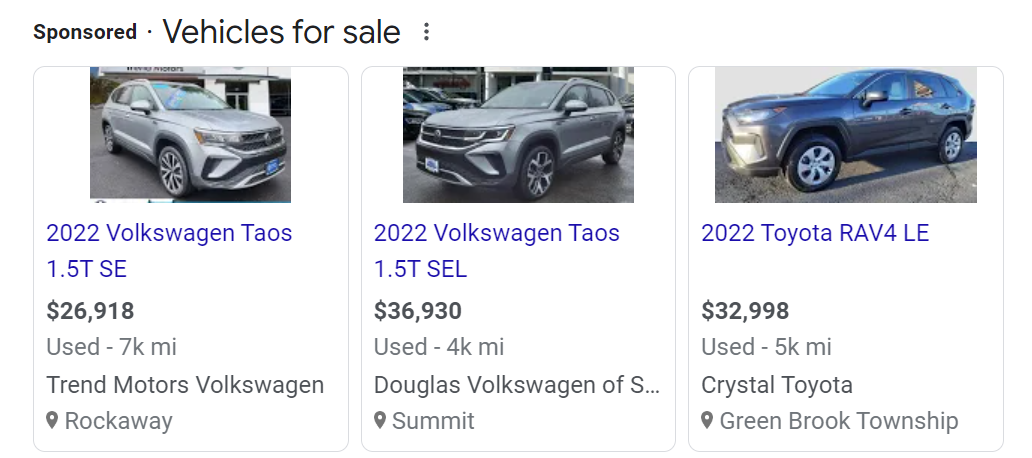
Google vehicle ads| Google
The attributes for your Google automotive feed are classified into three categories:
- mandatory for all vehicles included in the feed
- mandatory for certain types of vehicles included in the feed
- optional but highly recommended for all vehicles
Google automotive inventory feed requirements
|
Required attributes |
Recommended attributes |
|
Google product category Vehicle fulfillment VIN ID Store code Image link Link template Link Price Vehicle MSRP Condition Brand Model Year Mileage Color |
Title Product Type Additional image link Mobile link template Mobile link Ads redirect Certified pre-owned Trim Vehicle option Body style Engine Description Custom label Included destination Excluded destination |
Note: if you fail to provide any of the mandatory attributes for your vehicles, they may be rejected by Google. Not including recommended attributes will not prevent ads for your automotive products to appear but may negatively impact their performance.
Creation of Google Vehicle feed
Your vehicle feed must be created as either a spreadsheet (delimited text file) or an XML file.
To prepare and optimize your vehicle ads feed quickly, you can use DataFeedWatch and their pre-set template. Using such a tool will allow you to automate the process of your automotive feed creation.
They will be 5 steps you need to follow:
1. Connect your product data to DataFeedWatch.2. Create a Google vehicle ads feed using a pre-set template.
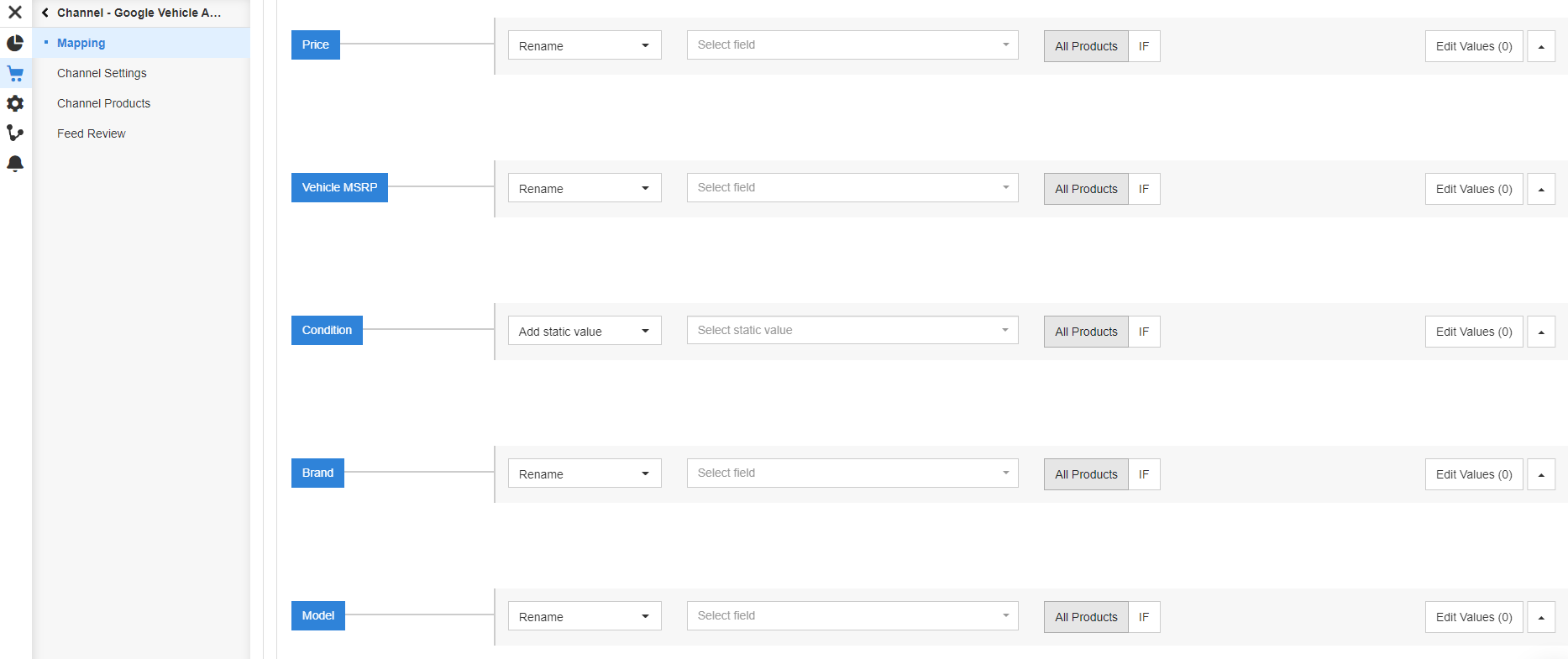
Mapping Google vehicle feed | DataFeedWatch
3. Match your data with Google’s required fields (mapping).
4. Review your feed.
5. Upload your Google automotive feed to Google Merchant Center.
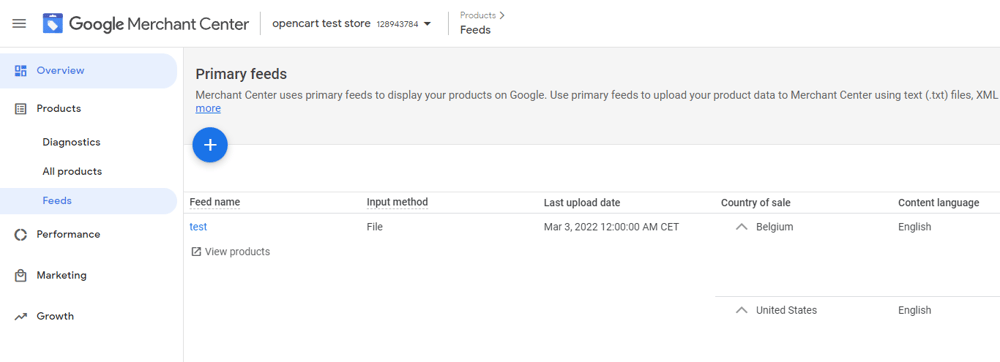
Uploading product feed to GMC | Google Merchant Center
Learn about each step in detail in this Google Vehicle Ads guide.
Facebook automotive inventory feed
The best and easiest way to upload your car product data to Facebook is to use a Facebook automotive feed.
Your Facebook automotive feed should include all relevant information about the vehicles you’re selling: state_of_vehicle (used/new), make, model, vin, body_style, price and more. In general, all mandatory fields must be included in your feed for you to run Facebook Automotive ads.
In addition to all the mandatory fields, you should also add some non-mandatory but recommended attributes. This can increase the visibility of your products on Facebook.

Facebook automotive ad, source: MarTech | Facebook
You have the option to either upload a single feed containing all your vehicles or use multiple feeds for specific types of vehicles, such as VANs or SUVs.
Facebook automotive feed requirements
|
Required attributes |
Recommended attributes |
|
Vehicle_id VIN Make Model Body_style Image Image:url (subset of image object above) Mileage.value Mileage.unit Url Title Price State_of_vehicle Exterior_color |
Trim Transmission Drivetrain Fuel_type Tag Interior_color Condition Sale_price Availability Custom_label_0 Date_first_on_lot |
If you choose to use a feed management tool like DataFeedWatch, you won't have to worry about feed specifications.
Creation of Facebook automotive feeds
Facebook accepts various feed formats including CSV, TSV, ATOM XML or RSS XML. You can create your feed manually or using a feed solution.
DataFeedWatch has pre-loaded templates with all the necessary requirements for Facebook automotive ads, including the file formats mentioned as well as required and recommended field names. All you need to do is enter your dealership's product data into the template provided for Facebook's automotive feed.
This is what the process of creating your Facebook automotive feed looks like:
1. Create a Facebook catalog with your automotive inventory data.
2. Connect your car product data to DataFeedWatch.3. Create a Facebook automotive feed using a DFW pre-set template for this channel.
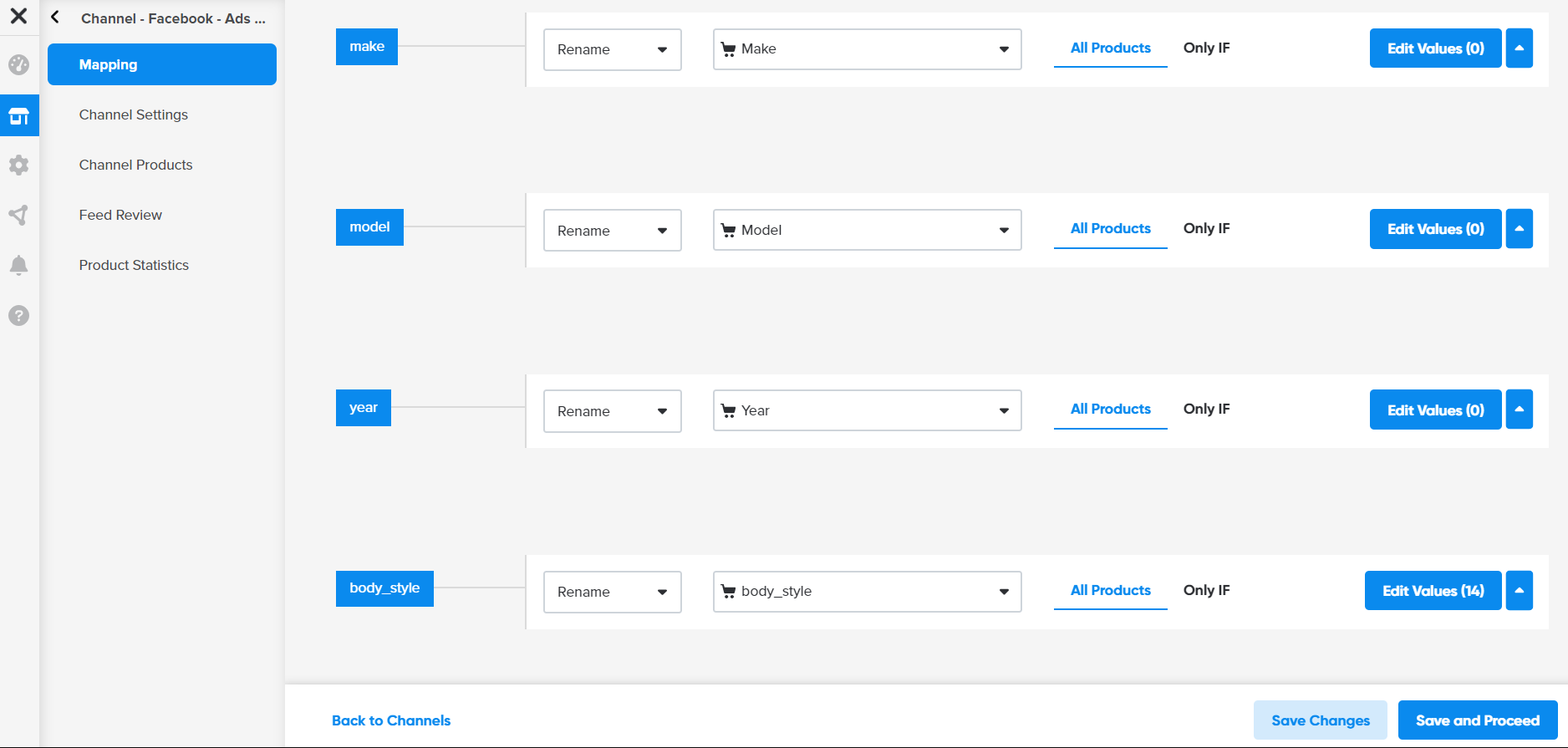
Mapping Facebook automotive inventory feed | DataFeedWatch
4. Review your feed.5. Upload your automotive feed to Facebook.
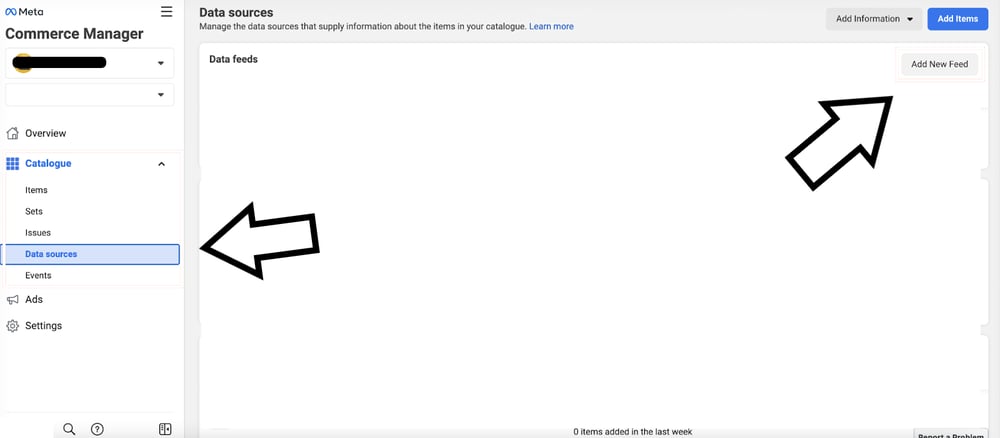
Uploading Facebook automotive feed to Facebook | Facebook Commerce Manager
Learn about each step in detail in this Facebook automotive inventory ads guide.
Microsoft auto inventory feed
Microsoft auto inventory feed is not much different from automotive feeds required on other platforms. This spreadsheet-like document contains detailed information about the vehicles available for sale.
Automotive Ads are dynamically created using car product data from your auto inventory feed. There’s no keyword-based targeting. The information used by Bing to target and generate your Automotive Ads is based solely on the information from your automotive feed. Therefore, it is important to optimize your inventory feeds for the most relevant keywords to increase the visibility of your automotive ads.
Microsoft automotive feed requirements
|
Required attributes |
Recommended attributes |
|
Country Final URL Image URL Make Model Price Title Target campaign Vehicle ID Vehicle type |
Body style City CO2 emission CO2 emission unit Drivetrain Engine Exterior color Fuel type Interior color State Trim Year |
There are also more attributes that are totally optional but still can increase your Microsoft automotive ads’ online visibility, such as Condition, Description, Mileage uni or Custom parameters. See the full list here.
Creation of Microsoft automotive feeds
Your Microsoft auto inventory feed should be in plain text and formatted with tabs to separate the different values. It should be saved in one of the following file formats: CSV, TSV, XLSX, or ZIP.
1. Create your Microsoft auto inventory feedAfter it’s created, you should upload your automotive ads' dynamic data feed to Microsoft.
2. Go to the top menu, select Tools > Business data > Dynamic data feeds.3. Then select Upload > Autos > Listing inventory.
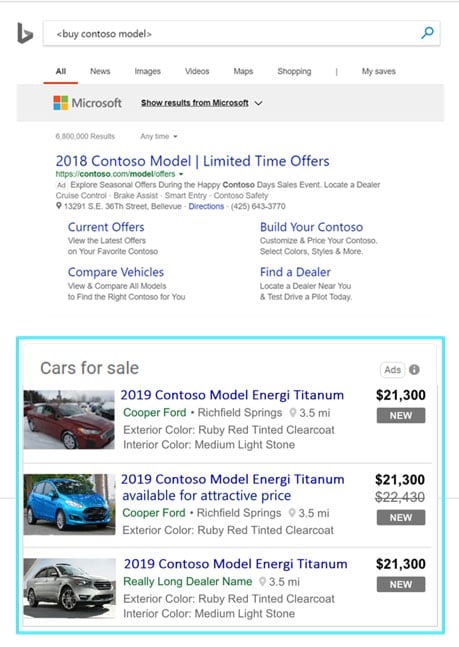
Example of automotive ads | Microsoft
Automotive feed optimizations that will boost your sales
Optimizing your automotive inventory feed can significantly impact your online sales. By ensuring that your feed contains relevant and optimized information, you can increase your chances of appearing in search results and reaching potential customers. In this section, we'll explore some effective strategies for optimizing your automotive feed to boost your sales.
1. Exclude out-of-stock and non-profitable items
When optimizing your automotive inventory feed, it's important to be aware of products that should be excluded from the feed. In the automotive industry, this will most often refer to those items that are out of stock/ discontinued or are not bringing you any profit.
You should identify your out-of-stock items in your automotive feed. You can do this by creating an availability rule as below:

Creating availability rule | DataFeedWatch
By excluding out-of-stock items from your automotive feed, you can improve the user experience and prevent customers from experiencing errors or frustration when trying to purchase out-of-stock vehicles. This way, you can also significantly improve your conversion rate.

Excluding out-of-stock products | DataFeedWatch
Norte Digital, an agency working for clients in the automotive industry, got incredible results by using DataFeedWatch. The implementation of the out-of-stock products exclusion strategy contributed to 620% increase in conversions.
Also, if you identify products that generate a lot of irrelevant clicks or are just low-priced, you can exclude them from your feed by using the "is in list" exclusion type.

Excluding non-profitable products | DataFeedWatch
2. Customize titles for automotive products
The titles of your automotive listings play a crucial role in determining their visibility in search results. To maximize your chances of appearing in relevant searches, it's important to include tailored and descriptive titles for each of your vehicles in your inventory feed.
For example, instead of simply using the product name, you may want to include additional details such as the make, model, year, and part number of the item. This can help differentiate your products from similar items and increase the likelihood of attracting qualified leads and ultimately generate more sales.
Using a feed solution such as DataFeedWmmatch, you can quickly combine different attributes into a compelling product title.

Creating product titles | DataFeedWatch
3. Segment your automotive campaigns
Custom labels are a powerful tool for segmenting your items inside your automotive campaign. By assigning custom labels to your products based on attributes like make, model, or price range, you can implement a separate bidding strategy for each group of products that you’ve created.
For example, you might create a custom label for luxury vehicles, middle-class vehicles and one for budget-friendly options. With custom labels, you can unlock new opportunities for segmentation and optimization, allowing you to maximize the results of your automotive ad campaigns.
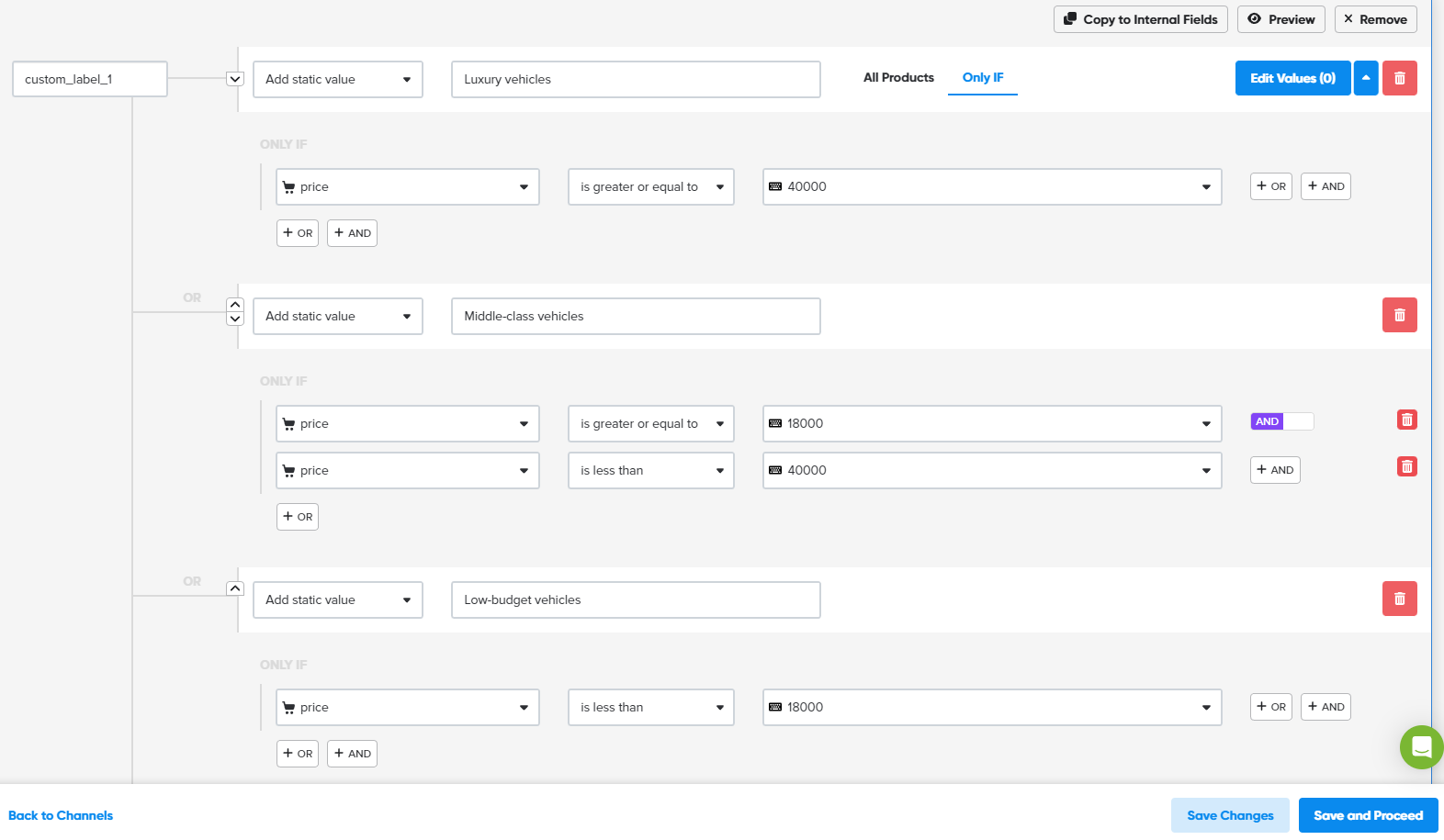
Creating custom labels | DataFeedWatch
4. Take advantage of remarketing
Automotive ads from Google, Facebook and Microsoft are all dynamic and utilize information from auto inventory feeds to create online car advertisements. That’s why setting up remarketing campaigns on these platforms is a relatively simple process.
Using the DataFeedWatch feed management tool, you can create an additional dynamic remarketing feed using the information based on your existing Google vehicle inventory feed. Alternatively, you can supplement your primary Google Merchant feed with additional attributes to be able to use it for multiple purposes.
Conclusion
Automotive feed management is a crucial aspect of any automotive business that wants to increase sales and grow its customer base. With the right feed management strategy, businesses can improve the accuracy and visibility of their vehicle inventory and reach new customers through various marketing channels.
However, to get the most out of automotive ad campaigns, businesses must keep up with the latest trends and technologies, stay on top of their inventory management, and ensure that their auto inventory feeds are optimized for different marketing channels. By following these best practices, automotive businesses can leverage their product feeds to drive growth and success in the competitive automotive industry.

